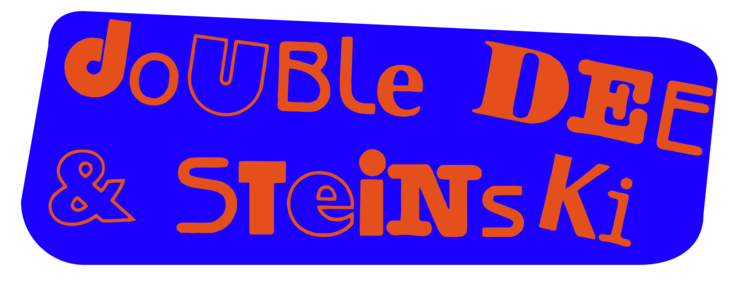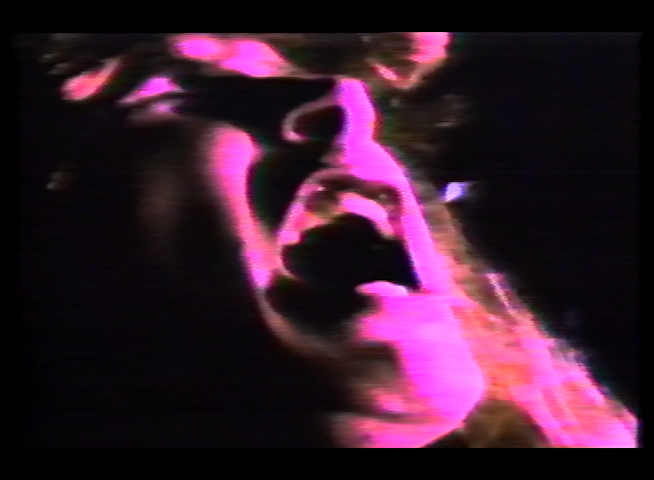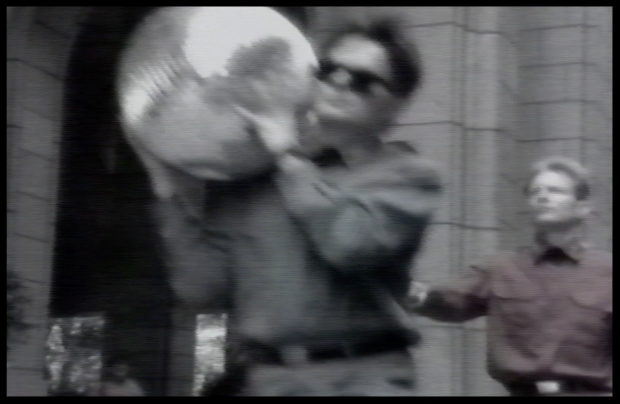MTV Mastermix (1990)
Double Dee and Steinski Influence MTV
by DD
MTV Mastermix was a show produced by Craig Coffman and myself in the Spring of 1990. Though not part of the Double Dee and Steinski resume there was a definite influence and mind set so by extension it is part of the family tree. Steinski did contribute some wonderful spoken word - thanks Steve!
I had the idea to make a clip show using the hooks of songs in music videos mixed well and interspersed with non sequitur spoken word based clips culled from previously produced spots or in house pieces. It was kind of like a mashed up Top 40 radio version of MTV. To glue together the videos pulled from the MTV library we created new video transitions mixed with whatever found audio that sounded cool: bites from Pop Will Eat Itself, R.Stevie Moore, Yello and music videos along with many contributions from the Steinski spoken word collection - physically absent Steinski was ever present in spirit after adding his voice to the mix.
We chose voice actor Hank Stohl to perform the role of announcer. I had done many commercials with Hank as well as some wonderful but lost comedy recordings. A really talented and funny guy he was known for his TV kid's puppet show and later as an actor and voice work.
I really wanted a non-stop dance mix video show but there was no way to make it commercial free. Watch the above video : here I've cut together some of the better segments and created something closer to the original idea: a nonstop video dance party.
“created for “The MTV Museum of UnNatural History” which was a traveling show that moved among selected malls around the country”
Rubin D. Herrera watches the "breathing" video wall at the MTV Museum of UnNatural History. photo - Carlos Antonio Rios, Houston Chronicle © 1988
From the Houston Chronicle March 25, 1988
The opening of the show was taken from a video Craig and I made called “The Mind Of MTV”: a short piece created for “The MTV Museum of UnNatural History” which was a traveling show that moved among selected malls around the country. "Mind" was displayed on a very cool custom built video wall with 16 tube monitors each controlled by a screw drive so that the tvs moved in and out and the wall appeared to breathe. Much of the video was used in some of the sections of the Mastermix show and it really set the tone for the series. The playlist was a mix of my available favorites (because of the song or a cool video) and current videos that fit the profile, and of course there were many that were "suggested" by the programming department. It was originally a mix of dance and rock, I've kept the compilation video mostly dance/hip hop.
Above is a promo for the MTV Museum Of UnNatural History, I may have even mixed this spot but I'm sure I would have saved a copy if I did.
It’s all about making do with what you’ve got. The majority of tv promo work I’ve done is a prime example of that. The client walks in a with an assortment of material and my task is to assemble it all into a coherent fashion that tells some kind of story. Here I had a collection of a fixed number of music videos preselected to work together. Add to that the transition pieces that we created and that’s about all I had to design an audio track that would “hopefully” look good when video was matched to it. Editor Denise Stabenau was responsible for finding ways to cut this stuff together - pulling shots from another part of the video or using our home made interstitial material to match shots or fill in holes. Often I painted myself into a corner and was left with a song that was too long or too short just so I could hit the show length, segment timings and keep a good pacing overall.
“ It is difficult creating a good product when there are so many interests involved ”
First airing 3/9/90 only 8 episodes were made with the show scheduled on a Friday Night Party Block. Eventually the show was cancelled sometime after Memorial Day - the numbers were low but we didn't have great expectations. Essentially it was a clip show, an excuse to play videos which is an excuse to sell airtime. We actually had big time sponsors but low ratings (like in the .5-.6 range if I remember correctly). It was exciting to make and just as frustrating. Audio was created and mixed first and then the video was matched in a final session.
I tried hard to include anything that I personally enjoyed and a some of the videos are classics with a few of them made by the same people I worked with on a daily basis. MTV staff producer Mark Pellington directed the video for De La Soul's "Say No Go" and Information Society's "What's On Your Mind?". And Glenn Lazzaro, my colleague at National Video Center did the oh so perfect editing on both as well. And since Glenn worked on the open/close and interstitial segments it really is a great collaboration between he and myself.
I chose many of my own favorites like the electro hits - MARRS "Pump Up The Volume"*, Bomb The Bass "Beat Dis" sampled Double Dee and Steinski in their tour de force and Janet Jackson's epic extended version of "All Right With Me" is just fantastic. The Devo video for "Disco Dancer" was an alternate version that was tossed off the channel after viewers watched and voted on MTV's "Smash or Trash?". The video was "trashed" and MTV refused to air it after that. Not a worthy fate in my opinion so I brought it back from the land of forgotten videos. Man Parrish's classic "Hip Hop Be Bop" is one of the lowest budget videos ever made but it's perfect for the electro anthem. The videos for Digital Underground "Doowatchalike" and "Humpty Hump" were directed by Tommy Boy employee and friend Rodd Huston who later became one of the premier and most heard voice overs in the tv and advertising.
(* MARRS actually contacted Steinski and I to ask permission to use the sample "Mars needs women" taken from our Lesson 3. "Of course" we replied, "we don't own it!").
Frame from the classic video and classic track "Say No Go" directed by MTV alumnus Mark Pellington.
I tried to keep the music as funky as I could but Programming had definite ideas about certain songs being played, so it was a pull and tug with me having to add songs I didn't think fit. If I had the final say I wouldn't have used any of the rock stuff but the show was kept as a mix of everything . It is difficult creating a good product when there are so many interests involved which is why Double Dee and Steinski exist: we operate in our own world where there are no limitations and it is just the two of us.
Grab from Buffalo Gals - World's Famous Supreme Team/Malcolm McClaren
“Glenn Lazzarro was the genius on line video editor I worked with”
The people involved in what you see go beyond Craig and I. Glenn Lazzarro was the genius on line video editor I worked with on much of my tv work from the 80's into the 90's and we still do today. We were responsible for a large body of MTV promo work during it's peak years. And there were many amazing producer/directors on staff that I also worked with: Richard Schenkman, Mark Pellington, Pam Thomas, John Payson and Peter Dougherty among those represented here. We all were responsible for creating the look of MTV both visually and aurally.
Technically it was my short lived period at the now defunct East Side Film and Video in the first 6 months of 1990 (the same studio ownership as my previous gig at Superdupe). I had a tight slickly designed room equipped with the NED Synclavier PostPro Tapeless system, SSL 6000 console, Otari MTR 90 with Dolby SR noise reduction, Lexicon 224 reverb, Meyer HD-1 near field monitors, UREI 604e big fucking speakers and a big honking 35” Mitsubishi tube tv monitor (which was the biggest at the time). I made great use of the famous bus compressors and an Aphex Dominator for final limiting. Everything was top notch and world class.
NED PostPro/Synclavier Tapeless system with unreleased Controller/Mixer ca. 1989
“That system I used cost around $200k and only gave me a total of 6 hours total with 8 tracks”
This was the early days of using a non linear audio system in post work, it was so ridiculously expensive. That system I used cost around $200k and only gave me a total of 8 hours total audio time distributed among 16 tracks. So it was a stretch to make an approximately 60 minute show. In some cases I would lower the sampling rate to fit all the audio if I needed a little extra time. That was one of the many unique properties of the Synclavier, a totally variable sample rate. And it sounded absolutely gorgeous with it's Apogee A/D and D/A converters. Combined with the SSL console and mixing to 30 ips Dolby SR masters was a dream. Without a non-linear system it would have taken much longer to experiment and put the show together in a day - shuttling and changing tapes could add many hours to the job.
After my brief stint at East Side I moved to National Video Center on W.42nd st. in NYC and upgraded to an even larger, more expensive system and a slightly less capable SSL 4000E. When Synclavier's company went bankrupt around 1992 National Video Center bought most of the remaining spare parts and hired one of the NED engineers who was able to further modify and maintain the systems throughout the decade. I think we eventually had 5 Synclavier systems going all together at National Video Center. National was also the home to Club MTV, Yo! MTV Raps, MTV Unplugged and the list goes on including nearly every major player in the tv/cable world.
Similar to the setup at East Side Film and Video here's my home at the time - Studio 4 at National Video Center in NYC around 1992 (where the remix for Steinski and Mass Media's "It's Up To You" was made). An SSL 4000 console, 32 voice 16 track Synclavier, Sony 3324 digital 24 track, Meyer HD-1 speakers and a tv monitor that lowered from a garage door opener: 0ver $600K spent here! It never fails to amaze me that I now have even more power on a Macbook Pro then I did then. Even my Ipad can do greater audio manipulation. So you can imagine how glad I am it wasn't my money spent on all that gear. It was a good time for leasing companies!
Each week during production I would receive a list of videos recommended by Production and add it to the master list. I couldn't obtain every video I wanted to use and in the end I felt hampered by the short list. And the restrictions we faced were a) we couldn’t alter the tempo, there was not time or money to change the video; and b) the videos had to come from the MTV library with the ok from the Programming department.
Each session took a long day, first inputting the audio portion of each video with matching time code from 30-40 songs in a pre production session. The sources were either 1" analog video, D2 digital or even 3/4" video cassette in a pinch. Often the beginning of the session involved recording new experimental vo with Hank Stohl, which sometimes flopped big time. Next I would decide what songs were good and matched tempos so a running order could be decided. In all it was a short list of a hundred or less videos to choose from so there was some repetition between the episodes. Just like Top 40 radio.
Screen grab from Peace Sells -Megadeath
Top to bottom it took about 12 hours to build and mix in audio, with the audio from the Synclavier output to 1/2" 4 track at 30 ips Dolby SR (time code on track 4). At the end of the session I would export an edit list to use in the next step, sending an audio master to editor Denise Stabenau (the post production pit-bull) to do the offline edit on a 3/4” tape system. I do not envy the painstaking work she did and she did it well. After that was approved the production moved to the unrelated National Video Industries (they had a nice cafeteria with hot meals every day) in downtime NYC for the final 5-6 hour build to 1" video master mastered with Dolby A noise reduction for broadcast.
Secret weapon I used to pump up the jam!
“In the early days in the MTV promo sessions we were able to use any music as a source”
Master mix could be made so much better and easier today but the main problems are the simple obstacle of obtaining legal rights and the non flexible early analog tape editing systems. In the early days of MTV promo sessions we got away with using (borrowing? stealing?) any music as a source for the spots. We all would pull music from any old place if it sounded good. After the lawyers saw what was happening they got involved and ruined the party. OK, everyone should get paid but this is all really promotion. We weren’t replacing the desire to hear your favorite songs, that was what the channel itself was doing - it was all promotion.
Devo in "Disco Dancer", the video was voted off MTV in an on air stunt along with some other poor videos. Personally I dig it a lot - it's a fun track and an exciting video cut from live performances.
Another problem was the audio quality on the MTV library tapes were all over the place. Some sounded excellent others included distortion, phase issues, tape hits or mistakenly mixed to mono audio. Today I would just replace all the songs with cd or digital files. However the mixes used in the music videos were often unique to that video and didn't exist in any other form so you were stuck with what you had on the video.
It's MTV's Mastermix! Mix! Mix! Mix!
In retrospect it was fun to make and watch especially when it ‘worked’. So as an entertainment it does work as a music video as well as audio sans picture. Which was refreshing for me as I was an audio guy in a video world much of the time and now I was able to put my mark on a tv program. The rule was "picture comes first"- oftentimes to the detriment of the audio quality. And in this show the music and sound was more important then normal.
Thankfully Denise Stabenau was so good finding ways to make the videos work together: I was essentially working blind only hearing the music but not seeing the picture. So I had no way of knowing if it would look good. Today's audio workstations have video incorporated so my problem is a thing of the past.
Out of the 8 produced shows there were a few episodes that really worked so that’s what you’ll see here. In my opinion shows 1 and 2 were not up to my expectations. Missing shows 7 and 8, I have a vague memory they were not worth keeping. Shows 3 and 4 probably being the best - I combined the best segments from both shows to make the composite episode you see here. The videos were transferred from VHS tape dubbed from the 1" video masters and I’m glad to have them - there’s no record or mention of Mastermix anywhere I searched.
So play it! Play it loud and watch it or don’t. I think you’ll find it fun either way.
Videos included
- C'mon and Get My Love - Cathy Dennis with D-Mob
- Room At The Top - Adam Ant
- Got To Get - Leila K
- Party Man - Prince
- Bass - Simon Harris
- B-52's Medley (Love Shack, Channel Z, Roam)
- Beat Dis - Bomb The Bass
- New Sensation - INXS
- Hip Hop Be Bop - Man Parrish
- Alright With Me - Janet Jackson
- My Prerogative - Bobby Brown
- Disco Dancer - Devo
- Michel'le - No More Lies
- Monkey - George Michael
- Close To The Edit -Art Of Noise
- Jazzie's Groove - Soul II Soul
- Buffalo Gals - Supreme Team with Malcom McClaren
- Get Up - Technotronic
- Say No Go - De La Soul
- Pump Up The Volume - MARRS
- Get A Life - Soul II Soul
- Pause - Run DMC
- Humpty Dance/Do Whatcha Like - Digital Underground
- She Drives Me Crazy - Fine Young Cannibals
- Oh Yeah - Yello
- What's On Your Mind? - Information Society
- Mexican Radio - Wall Of Voodoo









